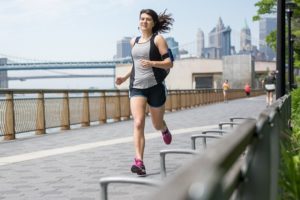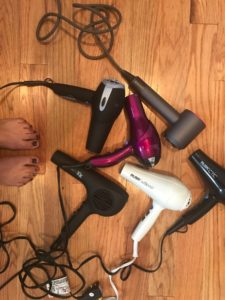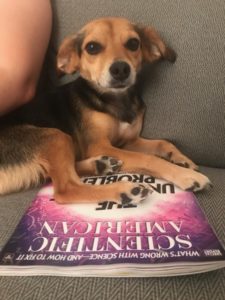
What I’m working on:
For my day job, I’m working on new buying guides to water flossers and menstrual pads, among other things, plus working on refreshing my guide to hairdryers. I don’t have any big freelance assignments at the moment, so I’m just keeping a list of pitch ideas going on my phone and enjoying a relaxed schedule.
Where I work:
My apartment in Brooklyn, Wirecutter’s test home—an apartment in Chinatown—or my desk at Wirecutter’s parent company, The New York Times (and here is where I say that I am speaking for myself and myself only).
Daily routine:
Ideally, I’m out the door first thing, at 7:00 a.m. or so, with my dog Ada. We head to Prospect Park, where we do a mini hike. The trails there are short, but enough to fully submerge us in the woods for a few minutes. I listen to podcasts—on news, health, or reality TV—for a bit, and then usually switch over to music at some point to fully zone out.
I’m back home by 8:00 a.m. or so. If I have a freelance project I’m working on, I’ll take an hour before the workday gets going to organize research materials, or do a phone call with a source or editor overseas.

Then, it’s time to do Wirecutter things, which primarily means writing buying guides. These are the length of a magazine feature (or three). The point is to recommend a product or two in a category—say, the best hairdryer. But to do that, I do a ton of reporting to get at what a hairdryer is: how it works, what marketing claims are bogus (most), which features are worthwhile. And then I test a bunch of hair dryers. And then write about it all. The whole thing takes a few months, and depending on where I am in that cycle with the guides I’m working on, my day might be largely testing, reporting, writing, or a mix.
I have a sort of unbelievable work setup at Wirecutter where I can work at home whenever I want. Mornings are usually when I have virtual meetings, from my home desk or couch. A couple days a week I have a recurring meeting with my primary editor, or a team meeting with editors and other writers, over a video service called Zoom.
Once a week, I break from work mid-morning to meet with a therapist, also over video. I started seeing an online therapist after reporting on the services earlier this year; like so many of the things I use in my personal life, these sessions serve the bonus purpose of being an ongoing test of a recommendation I’ve made.
I’ll fill in the rest of the morning with testing or writing.
Around noon or so, I might head to the Wirecutter test home for a photo shoot for one of my guides, or my desk at The New York Times. If I need to do a bunch of afternoon writing, I really like being at the Times. I find a little noise helpful. Sometimes I also need to come in to distribute products to my colleagues for testing. I get a kick out of walking into this important building, that I’d never even dreamed of being able to work in, with an armful of period underwear or slime kits or what have you.
If I stick around at home, I’ll do interviews and testing, or leave my desk for an hour or two in the afternoon to do errands or eat lunch somewhere or go for a run. My brain often feels a little sludge-y in the afternoon. It’s hard to use it for writing if I’m in my own home and do not have an immediate deadline. (There is nothing more motivating for me than a deadline; since most of my projects are long-term, I try to break them down into as many little deadlines as I can.)
Interviews are a great afternoon activity, though, as they give me something concrete to focus on in what otherwise can turn into an unproductive time of day for me. I talk to everyone from scientists to doctors to estheticians to PR folks. I came up through science writing, learning how to ask experts to phrase technical results in accessible language (“How would you describe this to someone at a party?”). When I’m talking to a person who does PR for a brand, I’m doing the opposite (“I need to speak to someone at your company who can explain this to me like I have a physics degree”). So much of what they’re used to telling journalists is surface-level, full of buzzwords that obscure how the tech that they’re selling truly functions.

If I’m working on a freelance piece, I might slot an interview for that in the afternoon, too. I like knocking all my phone time out back-to-back when I can. Talking on the phone used to make me very nervous, and I still find that I have more fun and success interviewing if I’m warmed up. My schedule at Wirecutter is flexible, which gives me space to work how I work best in both my job and my outside projects; it’s luxurious.
By six or so, I’m having dinner. Depending on how much I accomplished during the day, I might do some or even a lot of writing for Wirecutter after that. If I have a freelance assignment, I might work on that, too.
Otherwise, I’ll hang out with friends, go for a run, or maybe go do stand-up comedy at an open mic. I am a total beginner, and it feels good to have the toughest part of my week be something of almost total inconsequence.
Most productive part of my day:
For writing, after 6:00 p.m. I can’t do any tasks because no one is around. The best part of interviews is so often when I tell a source that I’m done with questions and ask, “Anything else to add?” And then now that they’ve loosened up, they’ll have an insight or some story they thought was silly but turns out to be amazing. My brain is like that, too. Sometimes when I’m all done with work (“done”), that’s when I’ll come up with something fantastic.
Most essential ritual or habit:
Exercise. It does wonders for my mental health and self-esteem. Without running, I’d be hiding under the covers all day. Right now I’m training for a marathon. But between races, I’ll have weeks where getting out for a 20-minute jog is an accomplishment. It all helps.
Favorite note-taking techniques/tools:
Just plain old notebooks. I have no preference; I’ll use any notebook I get for free at a conference, or buy in a bookstore in hopes of starting some lovely, poetic diary. They all get filled with my scrawl from interviews. Writing by hand helps me pay attention, even if I’m also recording. My interview notes are a fungus that take over every available scrap of paper.

How I keep track of my to-do list:
I put deadlines for work and filing pieces in one of two Google Calendars. I’ll use Google Docs for individual pieces to sketch out lists of things I need to do: tests, phone calls, papers to read, all that.
Essential software/apps/productivity tools:
Google Calendar, and Google Docs.
Favorite time waster/procrastination habit:
Is the correct answer Twitter, if I use it the most but deeply hate it?
My reading habits:
I rely a lot on links from Twitter. I promise myself all the time that I am going to be more organized about reading, but also, it’s genuinely valuable to be constantly getting recommendations on what to read from the range of folks that I follow. I go through phases with novels and science books—sometimes I’m reading a couple, sometimes nothing. I’m always working my way through an audiobook, most often something by a woman comedian. I feel lucky that the funny-essay genre is having a moment right now. As a reader, as a writer, I only ever want to feel like I’m sitting on a bar stool next to someone extremely smart having a conversation.
Sleep schedule:
Eleven to seven, ish. If I don’t get eight hours of sleep, I’m useless.


